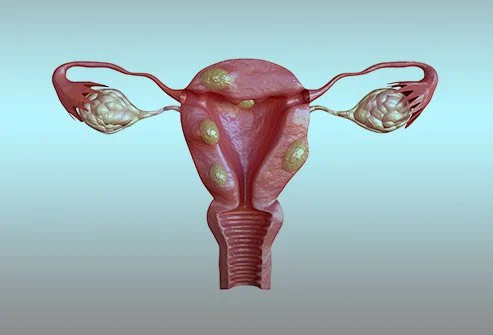Adenomyosis (ad-uh-no-my-O-sis) is a condition of the uterus where the endometrial cells (glands and stroma) i.e. those within the lining of the womb break through into the muscle wall of the uterus (myometrium). If Adenomyosis is localised or concentrated in the uterus, it is called Adenomyoma.
The term Adenomyosis is from the words: Adeno (gland), Myo (Muscle) and Sis (Condition). This usually results in an enlarged uterus, a distorted vasculature (blood vessels) and can lead to abnormal uterine bleeding and painful and heavy periods.
Adenomyosis is thought to be estrogen dependent and it’s symptoms usually lessen or disappear after menopause. When a person has their period, these cells also bleed, however the blood is trapped within the muscle layer.
The symptoms of adenomyosis are similar to that of Endometriosis but these conditions are different. With endometriosis, cells similar to those within the womb lining grow in other parts of the body such as the fallopian tubes, ovaries, bladder, bowels and can even grow in the lungs or diaphragm.
What causes Adenomyosis?
The cause of adenomyosis is not fully understood but there are a few theories:
- The lining of the uterus grows into the muscle layer.
- These cells were already in the muscle layer during foetal development before birth.
- Inflammation after giving birth can cause these cells to migrate through the weakened muscle layer.
Adenomyosis seems to be more common in:
- Women of reproductive age between 35 and 50
- Females who have had at least one pregnancy
- Those with endometriosis
- Those with uterine fibroids
- Those who have had an incision in their uterus such as a caesarean section.

What are the symptoms of Adenomyosis?
Adenomyosis does not always present symptoms. But many people experience the following:
- Painful menstrual cramps
- Heavy bleeding/menstruation
- Anaemia/iron deficiency
- Pelvic pain
- Painful intercourse
- Infertility
How is it diagnosed?
Adenomyosis is often diagnosed based on the symptoms experienced by the patients and also by one or more of the following:
- Pelvic examination – A doctor can perform an internal pelvic exam which indicates a larger, softer or more painful uterus when palpated
- Ultrasound scan – a transvaginal ultrasound scan uses sound waves to produce images of the organs. In this instance, it could show an enlarged or thickened muscle which may indicate adenomyosis.
- Magnetic Resonance imaging (MRI) – an MRI is better able to show thickening of the uterus muscle walls.
How is it treated?
There is no cure for adenomyosis currently, however various treatments can help with the symptoms.
- Pain relievers – the use of NSAIDS (Non-steroidal Anti-inflammatory Drugs) such as Paracetamol, Ibuprofen, Naproxen or Mefenamic acid can help to relieve pain. However, it should be noted that many sufferers do not find these drugs effective. Moreover, care should be taken as prolonged use of these medications have been found to have an adverse effect on the stomach lining.
- Hormonal medications and birth control – The presence of the female hormone estrogen causes thickening of the uterus wall. Therefore these medications can stop menstruation and therefore the periods. Medications such as the birth control pill, the Depo-provera injection, GNRH and the Mirena coil could all help with symptoms. However, it is important to understand how these medications work and their different side effects before using them.
- Uterine artery embolization – this is a minimally invasive procedure that involves blocking arteries from supplying blood to the affected part of the uterus. With this blood supply shortage, the Adenomyoma shrinks. prevents certain arteries from supplying blood to the affected area. With the blood supply cut off, the adenomyoma shrinks.
- High intensity ultrasound surgery – this procedure makes use of high intensity waves to create heat and damage the tissues. uses precisely focused high-intensity waves to create heat and destroy the targeted tissue. The heat is monitored using ultrasound images in real-time.
- Endometrial ablation – this involves destroying the uterine lining. However this may not reach the deep tissues within the muscles walls of the uterus. It may reduce heavy bleeding but not pain.
- Hysterectomyy – This is the only way to completely get rid of adenomyosis as the uterus is completely removed.




